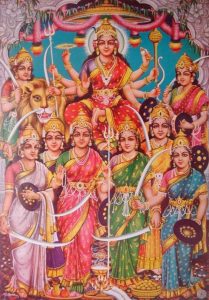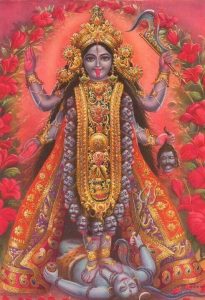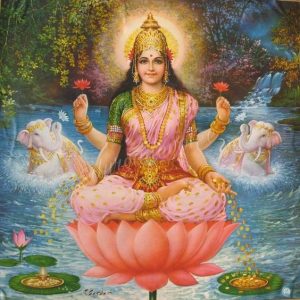
According to the Vedic calendar, immediately following Pitru Paksha comes a much more joyous celebration. That is the festival of Navratri (also spelled Navaratri). Navratri coincides with the beginning of the lunar month of Ashwina in Vedic astrology, or Jyotish. The first of nine nights of the Indian holiday of Sharad Navratri 2018 begins on October 9 in North America and Europe, and on October 10 in India.
Navratri 2018 marks nine nights of celebrating the goddesses Kali, Lakshmi, and Saraswati. Thus, there is one night for each of the Nav Durga (the nine embodiments of Durga). I will be posting on each of these, so please subscribe to the blog.
It is customary to recite the Chandi Path (aka Devi Mahatmyan) during Navratri. These verses comprise a hymn to one of the manifestations of Durga. You may also chant Navratri Devi mantras to the goddesses, the Devi Mahatmyam, or the Durga Saptashati. There are many Saraswati mantras which you can chant for wisdom and learning. For Lakshmi, you may wish to chant the Maha Lakshmi Stotram or the Maha Lakshmi Ashtakam. As each Sanskrit syllable has an inner sound vibration, it is beneficial to listen to these mantras as recited by native speakers or those trained in Sanskrit.
I spoke to Vedamurti Shri Vivekshastri Godbole, the head acharya (teacher) at the Shri Krishna Yajur Veda Pathashala in Satara, Maharashtra, India. He is a 16th generation Brahmin pandit. What follows is his elucidation regarding about Navratri.
THE NINE NIGHTS OF NAVRATRI 2018
“During Navratri, the first three nights are for Maha Kali (a form of Durga), then the next three nights are for Maha Lakshmi, and then the last nights are for Maha Saraswati. (The term “Maha” means “great” or “grand”). In a more subtle sense, each group of three nights is dedicated to one of the goddesses. The first night is Kali (pronounced Kaah-LEE), the second is Lakshmi(phonetically LUCK-shmee), and the third is Saraswati (Suh-russ-vuh-TEE). The fourth night is Lakshmi, the fifth is Kali, and the sixth and seventh are Saraswati. The eighth is Lakshmi, and the ninth night is for Kali.”
KALI

“Maha Kali is an embodiment of strength. She gives you bala or shakti. Maha Kali assists all kinds of laborers who work in the fields and farms and who don’t require that much academic intelligence in their work. They don’t have a lot of money or education. But, they do know how to put forth effort. All the time, most people in this world have to exert a great deal of a of effort. For them, Kali provides them with a lot of strength. For these people, the source of their wealth lies in their strength.”
(I mentioned to Vedamurti Vivekji about how in the West we often see images of Kali standing in the graveyard and with her tongue sticking out). “Kali appears in her ugra or fierce form for people who are ignorant and cruel. Her fierce demeanor is shown only to selfish people who are only thinking of what they want. They will steal from others. Otherwise, Kali is Mother Earth (Goddess Parvati). Ramakrishna Paramahamsa was a devotee of Kali and he was very humble. He did not see her furious form in her but envisioned her as his friend and the object of his worship. The way in which you perceive her is the form which she will display to you. People think they will kill an animal in front of her and then they will get happiness. Due to this ignorance, people kill animals and birds in front of Gods and Goddesses. This is adharmic and not according to the scriptures. We should kill the animal that displays itself as anger. We can also kill our lust and our ego. But people rarely think that way.”
LAKSHMI
“Maha Lakshmi  comes to us in the form of gold, silver, and gems. All types of wealth are Lakshmi. Some people have the false notion that Lakshmi means just gold or currency. In this world, every person is thinking only about finances, but Lakshmi represents more than that.She also has the attributes of good health, righteousness and generosity. She is radiant and full of gratitude. S0, the person who is healthy, wealthy, and generous is truly a rich person.”
comes to us in the form of gold, silver, and gems. All types of wealth are Lakshmi. Some people have the false notion that Lakshmi means just gold or currency. In this world, every person is thinking only about finances, but Lakshmi represents more than that.She also has the attributes of good health, righteousness and generosity. She is radiant and full of gratitude. S0, the person who is healthy, wealthy, and generous is truly a rich person.”
Shri Lakshmi is the consort of Lord Vishnu – the preserver of the universe. She is typically depicted on a lotus flower which is in a body of water and is surrounded by swans or elephants. She also has gold coins pouring from her hands.
In Vedic astrology, Lakshmi is the goddess associated with the planet Venus. Currently, Venus is very strong by virtue of its placement in the sky. Thus, it allows the divine feminine qualities to come forth easily and makes for a very propitious time to pay reverence to Lakshmi.
SARASWATI
“Maha Saraswati is pure knowledge. All kinds of knowledge and arts are related to Saraswati. This includes speech, writing,  studying, playing music, poetry, and singing.”
studying, playing music, poetry, and singing.”
During the nine nights of Navratri 2018, we pray to these goddesses. Durga embodies all three goddesses. There is a particular goddess to be worshiped for each of the nine nights. That will be covered in upcoming posts on this blog.
The festival of Navratri 2018 culminates with the ninth night of Ram Navami (or Maha Navami) on October 17 in North America and on October 18 in India and Europe. Please consult mypanchang for specific dates in your country – as they vary according to the phases of the Moon. Then Diwali, the festival of lights, is on November 6 in North America. However, India and Europe celebrates Diwali on November 7. Wishing you a very happy and joyous Navratri 2018!
